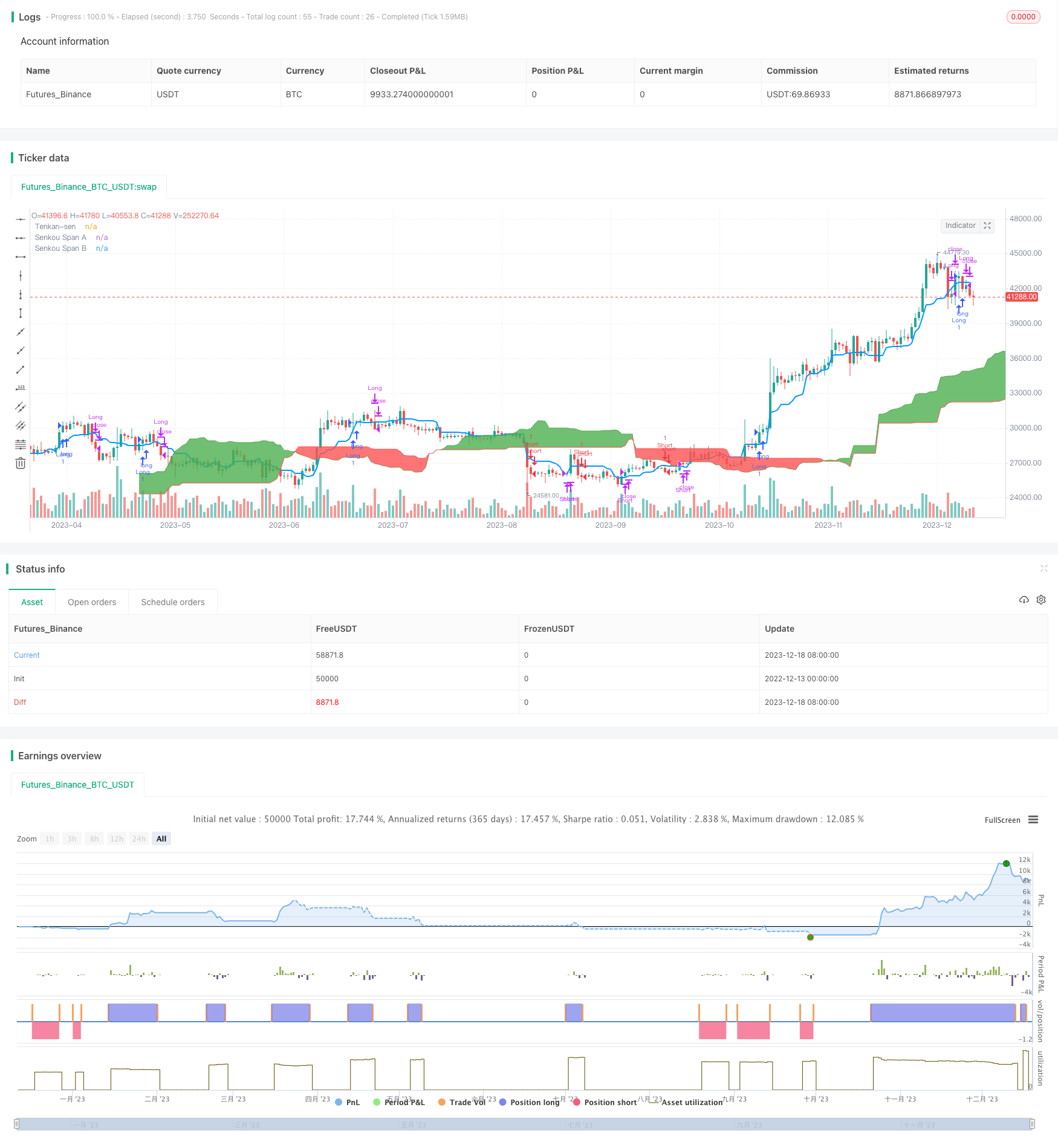
概述
该策略是一个基于Ichimoku技术指标的量化趋势追踪策略,主要通过特定的均线差异在特定条件下构建多空单,追踪市场趋势,并结合一定的止损机制控制风险。
策略原理
该策略的核心是基于一定参数设置下的Ichimoku指标构建交易信号。Ichimoku指标由转换线、基准线、前沿线和后退线四条线组成,其中转换线简称天线,基准线简称地线。策略通过设置天线和地线的不同参数,形成金叉死叉交易信号。另外,该策略还结合了云带的突破作为辅助条件来发出入场信号。
具体来说,策略主要根据以下几个交易规则:
当价格上穿天线,并且脱离云带的时候做多;
当价格下穿天线的时候平多仓;
当价格下穿地线,并且进入云带的时候做空;
当价格上穿天线的时候平空仓。
通过这样的多空交易规则,可以有效捕捉市场的趋势行情。同时,结合云带的突破作为过滤条件,可以一定程度上避免错买错卖。
策略优势分析
相较于其他常见的均线交易策略,该策略具有以下几个优势:
基于Ichimoku指标,对趋势判断更准确。Ichimoku指标由多条均线组成,综合判断趋势更为可靠,避免单一均线产生的噪音。
多条均线组合,形成交易过滤效果更好。突破云带作为附加条件,可以避免错误信号。
风险可控。通过设置止损天线,可以及时止损,有效控制风险。
回撤较小。相较于其他趋势策略更少产生较长时间的逆市操作,最大程度减少回撤损失。
参数调整灵活。可以根据市场行情通过调整均线参数灵活适应不同行情。
风险及优化分析
该策略仍然存在一定的风险需要注意:
震荡行情表现较差。当出现长时间震荡整理的市场时,该策略容易产生小幅度的反复交易导致浮亏。
趋势反转识别不足。Ichimoku指标对于短期内的趋势反转判断能力较弱,可能错失反转机会或遭遇突然反转的风险。
参数设置依赖经验。不同参数设置会对策略表现产生较大影响,需要依赖丰富的历史经验进行调整。
针对上述风险,该策略可以从以下几个方面进行优化:
结合波动率指标等判断震荡行情,设置策略状态避免无效交易。
增加趋势反转信号模块,如加入移动平均线反向交叉组合判断。
利用机器学习等方法自动优化参数,减少人工经验依赖。
设置动态止损线。根据市场波动性实时调整止损幅度,降低风险。
总结
整体来看,该策略整合利用Ichimoku指标的优势,在捕捉趋势行情方面表现出较强的优势。通过适当参数设置及优化调整,可以进一步提高策略稳定性,使其成为一个值得考虑投入实盘的高效策略。
/*backtest
start: 2022-12-13 00:00:00
end: 2023-12-19 00:00:00
period: 1d
basePeriod: 1h
exchanges: [{"eid":"Futures_Binance","currency":"BTC_USDT"}]
*/
//@version=3
strategy(title="RENKO ICHIMOKU STRATEGY", shorttitle="RENKO ICHIMOKU STRATEGY", overlay=true)
ro = open
rc = close
tenkanSenPeriods = input(10, minval=1, title="Tenkan-sen"),
kijunSenPeriods = input(30, minval=1, title="Kijun-sen")
SenkouSpanBPeriods = input(60, minval=1, title="Senkou Span B"),
displacement = input(30, minval=1, title="Chikou Span (Displacement)")
donchian(len) => avg(lowest(len), highest(len))
tenkanSen = donchian(tenkanSenPeriods)
kijunSen = donchian(kijunSenPeriods)
SenkouSpanA = avg(tenkanSen, kijunSen)
SenkouSpanB = donchian(SenkouSpanBPeriods)
plot(tenkanSen, color=#0496ff, linewidth=2, title="Tenkan-sen")
// plot(kijunSen, color=#991515, title="Kijun-sen")
// plot(close, offset = -displacement, color=#459915, title="Chikou Span")
p1 = plot(SenkouSpanA, offset = displacement, color=green, title="Senkou Span A")
p2 = plot(SenkouSpanB, offset = displacement, color=red, title="Senkou Span B")
fill(p1, p2, color = SenkouSpanA > SenkouSpanB ? green : red)
// Entry/Exit Signals
tk_cross_bull = tenkanSen > kijunSen
tk_cross_bear = tenkanSen < kijunSen
price_below_tenkan = open < tenkanSen and close < tenkanSen
price_above_tenkan = open > tenkanSen and close > tenkanSen
price_below_kinjun = close < kijunSen
price_above_kinjun = close > kijunSen
tekan_above_kinjun = tenkanSen > kijunSen
tekan_below_kinjun = tenkanSen < kijunSen
ss_high = max(SenkouSpanA[displacement-1], SenkouSpanB[displacement-1])
ss_low = min(SenkouSpanA[displacement-1], SenkouSpanB[displacement-1])
price_inside_kumo = close > ss_high and close < ss_low
price_below_kumo = rc[1] < ro[1] and rc[0] < ro[0] and rc[1] < ss_low
price_above_kumo = rc[1] > ro[1] and rc[0] > ro[0] and rc[1] > ss_high
cs_cross_bull = mom(close, displacement-1) > 0
cs_cross_bear = mom(close, displacement-1) < 0
bullish = cs_cross_bull and not price_inside_kumo
bearish = cs_cross_bear and not price_inside_kumo
strategy.entry("Long", strategy.long, when=price_above_kumo and price_above_tenkan )
strategy.close("Long", when=price_below_tenkan )
strategy.entry("Short", strategy.short, when=price_below_kumo and price_below_tenkan )
strategy.close("Short", when=price_above_tenkan )
// longCondition = crossover(sma(close, 14), sma(close, 28))
// if (longCondition)
// strategy.entry("My Long Entry Id", strategy.long)
// shortCondition = crossunder(sma(close, 14), sma(close, 28))
// if (shortCondition)
// strategy.entry("My Short Entry Id", strategy.short)